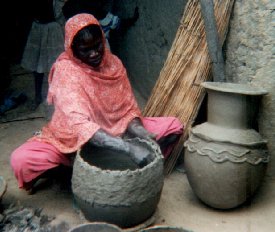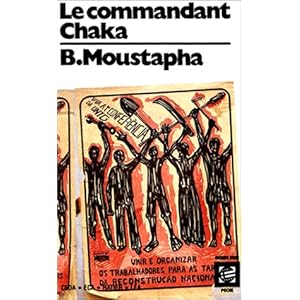Chadian
art tends to fall into two categories: functional art, and art that is made for
tourists. Items that fall into the functional art category would be baskets,
clay pots, woven fans, etc. The woven fans and baskets are dyed with pigments
from plants, flowers, and other natural ingredients, with purple and green being
the most widely used colors.
When
I think about making clay pots, I think of slapping the clay on a potters wheel
and forming the pottery on that.
But in Chad, many don’t have that luxury. They form it strictly with
their hands. And whereas we use a kiln to fire the pieces (which are really
expensive – I’ve looked into buying one), they start a fire with pieces of wood
and straw and get it really hot. Then they put the piece in the fire. And after
a while, they cover the piece and the fire in sand and leave it there
overnight.
And
of course, there is the other kind of art: that for the tourist. This includes
greeting cards, post cards, paintings, various textile arts, jewelry, etc. Most
of this art is created by women to supplement the family’s income while the men
are out doing agricultural work or other manual labor work.
French
is the major language of Chadian literature, although some writers do produce
written works in Arabic as well. Chadian authors actually tend to sell more
works in France because the instability of the government. The repressive nature of anyone who
dares to speak out against the conditions in the country makes it really hard
for these writers to get published. There are many books written about the
conditions of their country and criticisms of the government. Of course, there are also many books
written on folklore, legends, and other stories that have been passed down.
There
aren’t too many Chadian authors that are well known, and especially outside of
Chad and France. Ahmat Taboye is the country’s lone literary critic. He published his Anthologie de la littérature tchadienne in 2003, noting forty years
of Chadian literature. He currently works at the University of N’Djamena as the
head of the Department of Letters.
Joseph Brahim Seïd was a writer and politician (serving as Minister of
Justice during the late 1960s-early 1970s) who wrote a couple of books in the
1960s. Baba Moustapha was a playwright whose finest work was published a year
after his death in 1983, a play called Commandant
Chaka. Antoine Bangui was a politician and was imprisoned for three years
in the 1970s because he disagreed with President Tombalbaye and got on his wrong
side. When he was released he published a book on his time in prison followed
by an autobiography. His life afterwards is a mix of various political
activities and writing more books. Koulsy Lamko is a playwright and novelist
among other things, who studied in Burkina Faso where he met Thomas Sankara. He
later studied in Rwanda where he wrote his only novel – La phalène des collines, about the 1994 Rwandan genocide.
Up
next: music and dance



No comments:
Post a Comment